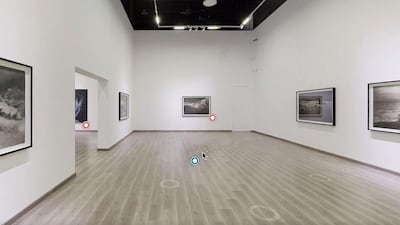Months into the Covid-19 outbreak, we have passed the flurry of confused responses. We are all at home, working (or trying to), and cultural organisations have gone from sending out cancellation notifications to sending emails about live-streamed webinars and lectures.
Now, from my living room sofa, I can wander around the New York Museum of Modern Art’s revamped galleries, attend a performance exchange lecture with a Tate Modern curator, listen to NYUAD’s spoken-word poetry event, Rooftop Rhythms, and check out shows at Alserkal Avenue. But logging on to these events is very different from attending them in person, not only in the obvious ways – no need to brush your hair – but in terms of the cultural logic behind each event.
Museums are built on the notion of being accessible to the widest audience possible. Subsidies in many countries are directly related to footfall: the more who visit, the more they get. But it does not work like this online: social media advertisements are prized for their ability to target narrower subsections of the public.
In an interesting exchange during Art Dubai’s Global Art Forum webinar, Shumon Basar, the forum’s commissioner, and Rahul Gudipudi, exhibitions curator at Jameel Arts Centre, discussed how the coronavirus has shunted life towards online consumption.
Basar wondered whether the notion of connectivity could be considered a human right; Gudipudi responded it could, citing the January ruling by India’s Supreme Court, in response to the internet shutdown in Kashmir, recognising access to the internet as part of freedom of speech.
This freedom of speech governs the information that passes along on the internet, but not the right for others to access it. The model here is the rhizome: where any point can be connected to any other, no matter how different or similar.
Developed by French philosophers Deleuze and Guattari in the 1970s, the rhizome is frequently used as the visual metaphor for the internet. It’s also a metaphor for the spread of a virus: from person to person. As the successful shift of entire white-collar economies to individual kitchen tables demonstrates, the coronavirus has hit a population that had been preparing for social distancing for a long time. Not only in that we have been practising isolation on social media, but we have also changed our way of thinking from pre-internet days.
Large portions of the population already “come together” as “followers” such as on social media. Curated news feeds encourage solipsism, and algorithms create echo chambers.
After lockdowns are lifted, organisations will return to putting on events, with programmes structured around the capacity of how many people can come together in a space. However, how much this present moment will really alter arts programming is unclear. But, at least to my mind, it has put into focus both the positives of coming together in a public space, as well as the ways museums could use digital programming in more interesting and helpful ways.
By this I mean leaning into the specificity, instead of away from it, such as micro-targeting communities underserved by cultural organisations, and seeing what forms of creativity and art histories exist there, or giving audiences more of a voice to speak back.
On a conceptual level, the liberatory promise of Deleuze and Guattari’s rhizome was that it was multiplanar and creative, throwing aside a hierarchical model, where connectivity doesn’t have an entrance point.
The coronavirus is the same: it disregards conventional biases around class, wealth and nationality – the invisible boundaries that render public spaces, especially the art world, not truly open – and its chain of transmission has made people previously overlooked by certain sectors of society more visible, almost as if we are seeing the world through the perspective of the virus.
We have begun to think through the rhizome in everyday life, following chains of connection, a lead museums would do well to follow.


